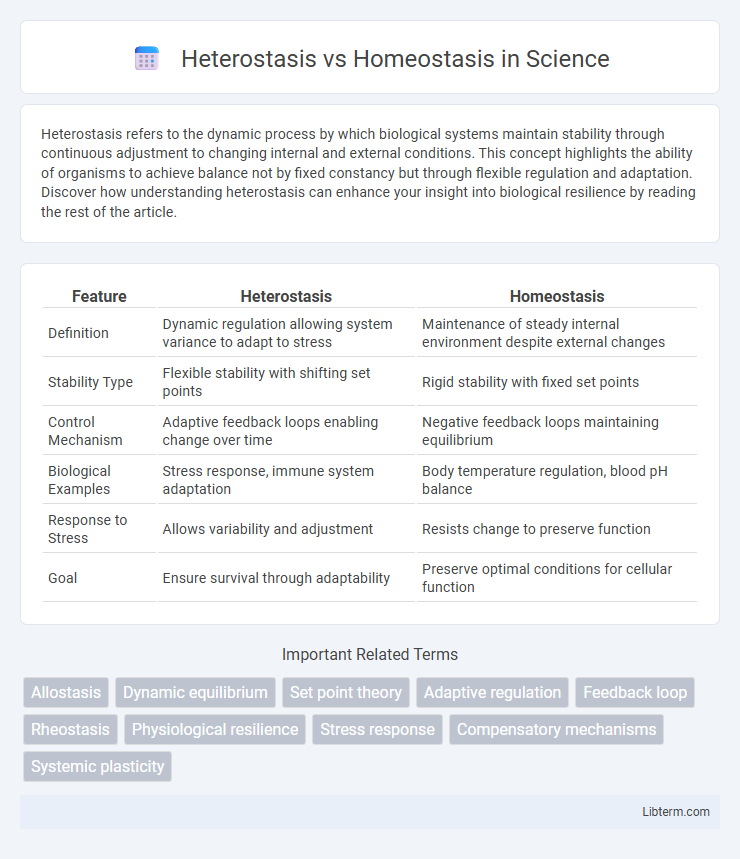Heterostasis refers to the dynamic process by which biological systems maintain stability through continuous adjustment to changing internal and external conditions. This concept highlights the ability of organisms to achieve balance not by fixed constancy but through flexible regulation and adaptation. Discover how understanding heterostasis can enhance your insight into biological resilience by reading the rest of the article.
Table of Comparison
| Feature | Heterostasis | Homeostasis |
|---|---|---|
| Definition | Dynamic regulation allowing system variance to adapt to stress | Maintenance of steady internal environment despite external changes |
| Stability Type | Flexible stability with shifting set points | Rigid stability with fixed set points |
| Control Mechanism | Adaptive feedback loops enabling change over time | Negative feedback loops maintaining equilibrium |
| Biological Examples | Stress response, immune system adaptation | Body temperature regulation, blood pH balance |
| Response to Stress | Allows variability and adjustment | Resists change to preserve function |
| Goal | Ensure survival through adaptability | Preserve optimal conditions for cellular function |
Introduction to Homeostasis and Heterostasis
Homeostasis maintains internal stability through dynamic equilibrium, regulating factors like temperature, pH, and fluid balance to ensure optimal cellular function. Heterostasis, in contrast, refers to the body's adaptive state that allows temporary deviations from homeostasis to meet changing environmental demands or stressors. While homeostasis seeks to restore baseline conditions, heterostasis enables physiological flexibility by establishing new set points during periods of challenge.
Defining Homeostasis: The Principle of Stability
Homeostasis is the biological principle of maintaining internal stability despite external fluctuations, ensuring optimal functioning of cells and organs. It involves regulatory mechanisms that regulate variables such as temperature, pH, and glucose levels within narrow ranges essential for survival. This dynamic equilibrium enables organisms to adapt to environmental changes while preserving consistent internal conditions.
Understanding Heterostasis: Embracing Dynamic Change
Heterostasis refers to the body's ability to maintain stability through constant change and adaptation to varying internal and external conditions, contrasting with homeostasis' emphasis on maintaining a fixed internal balance. This dynamic process involves flexible physiological adjustments, such as fluctuating hormone levels and metabolic rates, allowing organisms to thrive in unpredictable environments. Understanding heterostasis highlights the importance of resilience and adaptability in biological systems, especially under stress or rapidly changing conditions.
Key Differences Between Homeostasis and Heterostasis
Homeostasis maintains internal stability through constant conditions like temperature and pH within narrow ranges to support optimal cellular function. Heterostasis allows for dynamic adjustments and variable set points in response to changing environmental demands, promoting adaptability and resilience. The key difference lies in homeostasis's emphasis on equilibrium versus heterostasis's focus on flexible regulation and situational variation.
Biological Examples of Homeostasis
Homeostasis maintains internal stability in organisms, exemplified by human body temperature regulation through sweating and shivering to balance heat production and loss. Blood glucose levels are controlled by insulin and glucagon secretion, ensuring energy supply remains within optimal ranges. Kidney function also demonstrates homeostasis by adjusting water and electrolyte balance, vital for cellular function and overall fluid stability.
Real-World Cases of Heterostasis
Heterostasis refers to the dynamic adjustment of physiological systems to varied and unpredictable environmental changes, unlike homeostasis, which maintains stability around a set point. Real-world cases of heterostasis include the way migratory birds rapidly shift metabolic rates to adapt to changing climates and altitudes during long flights, or how the human immune system modulates responses to new pathogens without maintaining a fixed internal state. These examples illustrate heterostasis as a flexible biological strategy enabling survival in fluctuating conditions rather than strict equilibrium maintenance.
Mechanisms Regulating Homeostasis
Homeostasis is regulated by complex feedback systems involving sensors, control centers, and effectors that monitor and adjust physiological parameters such as temperature, pH, and glucose levels. Negative feedback loops play a critical role by detecting deviations from set points and initiating responses to restore balance through mechanisms like hormone secretion and neural signals. In contrast to heterostasis, which allows adaptive change and dynamic equilibrium under stress, homeostatic mechanisms maintain internal stability to support optimal cellular function and systemic health.
Adaptive Responses in Heterostasis
Heterostasis involves dynamic adaptive responses that enable an organism to maintain function under varying and extreme environmental conditions by shifting physiological set points. Unlike homeostasis, which aims to preserve a stable internal environment, heterostasis emphasizes flexibility and reversible adjustments in metabolic, cellular, and systemic processes. These adaptive responses in heterostasis include altered gene expression, enzyme activity modulation, and receptor sensitivity changes to optimize survival during stress or environmental fluctuations.
Importance in Health and Disease Management
Heterostasis enables dynamic adaptation to complex and fluctuating internal and external environments, crucial for maintaining physiological resilience beyond the static equilibrium of homeostasis. In health and disease management, understanding heterostasis allows for more effective interventions by recognizing variable set points and the body's ability to endure stress and recover, improving chronic condition treatments and acute response strategies. Targeting heterostatic mechanisms can enhance personalized medicine approaches, optimizing therapeutic outcomes and preventing disease exacerbation through adaptive regulation.
Future Perspectives: Homeostasis, Heterostasis, and Human Well-being
Future perspectives on homeostasis and heterostasis emphasize their combined roles in enhancing human well-being by balancing stability and adaptive change. Advances in biotechnology and personalized medicine aim to leverage heterostasis to improve resilience against stress and disease, while maintaining homeostatic equilibrium for optimal physiological function. Integrating these concepts could lead to innovative therapies that promote long-term health by dynamically adjusting the body's regulatory mechanisms.
Heterostasis Infographic

 libterm.com
libterm.com